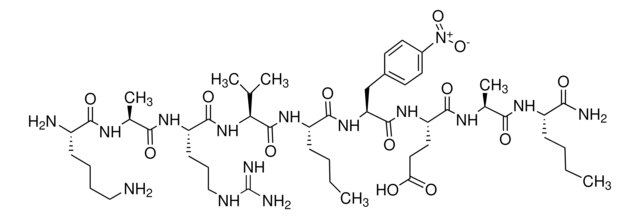This product has been discontinued without a replacement. Technical Service has no data describing its use in testing cell lysates.
MAK255
Cysteine Assay Kit (Fluorometric)
sufficient for 100 fluorometric tests
Synonyme(s) :
Cysteine Quantitation Kit
Sélectionner une taille de conditionnement
527,00 €
Sélectionner une taille de conditionnement
About This Item
527,00 €
Produits recommandés
Méthode de détection
fluorometric
Maladie(s) pertinente(s)
cardiovascular diseases
Température de stockage
−20°C
Description générale
Caractéristiques et avantages
Adéquation
Principe
Code de la classe de stockage
10 - Combustible liquids
Point d'éclair (°F)
188.6 °F - closed cup
Point d'éclair (°C)
87 °C - closed cup
Faites votre choix parmi les versions les plus récentes :
Certificats d'analyse (COA)
It looks like we've run into a problem, but you can still download Certificates of Analysis from our Documents section.
Si vous avez besoin d'assistance, veuillez contacter Service Clients
Déjà en possession de ce produit ?
Retrouvez la documentation relative aux produits que vous avez récemment achetés dans la Bibliothèque de documents.
-
is this product suitable for cell lysate? If possible, i need protocol to prepare sample(cell number, how to lysis etc.)
1 answer-
Helpful?
-
-
Could N-acetyl Cysteine interfere with the MAK255-1KT Cysteine Assay Kit (Fluorometric)? Additionally, would residual H2S also interfere with the assay?
1 answer-
Since the assay principle is based on the cleavage of the thiol group in reduced Cysteine, N-acetyl Cysteine, which contains the thiol group, is likely to be included in the quantification of cysteine present in the biological fluids by the kit. Additionally, the assay should detect Hydrogen sulfide generated by the enzymatic metabolism of Cysteine. Therefore, sulfide salts (such as Sodium sulfide) as well as residual Hydrogen sulfide in the sample would likely be a significant source of interference.
Helpful?
-
-
Are the standards run in kinetic or endpoint mode? How are they plotted?
1 answer-
The standards are run in kinetic mode as well. It's important that the delta T (T2-T1) remains consistent for both the standards and the samples, and in all cases, it should fall within the linear range of the plot. For instance, samples could be read from T=2 to T=4 (assuming linearity) and the standards could be read from T=3 to T=5 (again, assuming linearity), ensuring that the delta T remains the same. Subsequently, the delta RFU is plotted for the standards against concentration, and then the samples can be plotted using their delta RFU to determine the concentration.
Helpful?
-
-
Is the product Cysteine Assay Kit (Fluorometric) MAK255 suitable for use with blood plasma?
1 answer-
The Cysteine Assay Kit (Fluorometric) MAK255 is suitable for use with mammalian plasma samples. Centrifugation of plasma samples is not necessary, as they can be used directly. While the choice of anticoagulant would not make a significant difference, it is generally recommended to avoid EDTA or citrate, which are chelators, and to use heparin instead.
Helpful?
-
Active Filters
Notre équipe de scientifiques dispose d'une expérience dans tous les secteurs de la recherche, notamment en sciences de la vie, science des matériaux, synthèse chimique, chromatographie, analyse et dans de nombreux autres domaines..
Contacter notre Service technique


